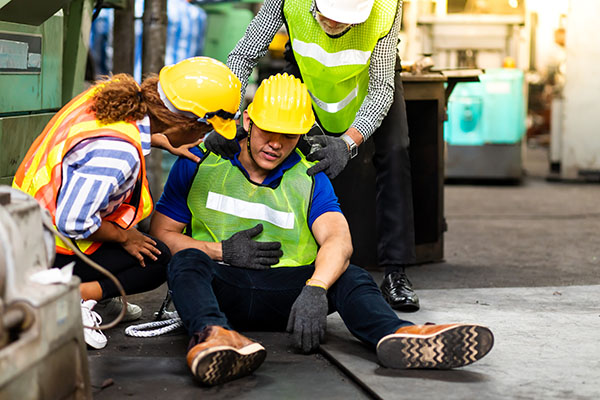First aid is a vital component of work health and safety (WHS) at the workplace.
If you are running a business , make sure you are familiar with the relevant legislation about workplace first aid.
Heaven forbid but when an accident happens in your workspace, be sure you have materials and expertise during such times.
The law states the requisites for first aid in the workplace. Anything in your business that falls short of safety requirements can have damaging repercussions.
If you need support or a consultant to discuss these requirements, WHS Matters can help. Our expert consultants can perform an onsite check within your facilities. We can help you ensure your workers are fully protected.
Why First Aid Is Beneficial
 First aid is beneficial because:
First aid is beneficial because:
-
It does not only help save lives. It creates confidence among workers for giving care.
-
The one who gives care can assure comfort (to the victim).
-
First aid provides the tools to use to prevent the worsening of a situation.
-
First-aid know-how encourages safe and healthy practices.
First aid is your workforce’s tool to use during accidents. When an accident occurs, they do not feel helpless. Because they have first-aid know-how, they can intervene and offer help. In short, they can do something in such a situation.
Who Is Responsible for Health and Safety in the Workplace?
The WHS Act specifies the persons as duty holders concerning first aid:
-
PCBU (person undertaking a business or undertaking)
-
Officers
-
Importers, manufacturers, and designers
-
Suppliers and installers of structures, plants, and substances
The duties of a PCBU include the provision of first aid equipment and making sure that everyone has access to equipment. Importers, manufacturers, installers, and designers, on the other hand, must ensure that the materials, structures, and substances they use or build do not present risks to health and safety.
Officers (at the top tiers of the organisation) function as overseers. They ensure compliance among other duty holders based on the WHS requirements.
These codes/policies also state the specifics on the dynamics between and among these roles. For instance:
-
A person can have two duties
-
More than one worker can be assigned the same duty concurrently
-
A PCBU need not provide equipment and make it accessible to everyone if another PCBU has already done so.
-
Officers should consult with workers about facilities and equipment needed in first aid.
Determining First Aid Requirements in the Workplace
 When providing access to first aid equipment and facilities, duty holders must take into account pertinent matters, including:
When providing access to first aid equipment and facilities, duty holders must take into account pertinent matters, including:
-
Nature of work
-
Nature of risks and hazards
-
The location and the size of the work area
-
Number of workers and other persons
-
Composition of workers and other persons
Other persons refer to visitors/customers. They must also comply with the rules. At the very least, they must take care of their health and safety when in a workplace.
First Aid Kit Requirements
For this particular section, refer to the Code of Practice for First Aid In The Workplace. Along with other specifics about first aid compliance, the code details for assembling first aid kits.
-
Location and Quantity
-
Workplaces with low risk – one kit for 10 to 50 employees
-
Workplaces with high risk – two kits for 25 – 50 employees, with specific modules
-
In the absence of timely access to medical and ambulance service – at least one kit for every 25 employees
-
For separate work areas – Provide portable kits for each work area and allocate a central first-aid facility. The kit may include motor vehicles for quick transport in case of an emergency or accident.
-
Contents of Kits
First aid requirements for materials and tools vary from one work area to another. Ensure that kits are always adequately stocked for your operations. A few examples as follows, but refer to the Code for further guidance:
- Emergency rescue blanket for shock or hypothermia
-
Resuscitation mask (or shield)
-
Disposable gloves
-
Sterile adhesive dressings / Triangular bandage / Non-adherent wound dressings / Crepe bandage etc.
-
Eye pads
-
Safety pins / Note book and pen
-
Non-allergenic tape / Antiseptic liquid/spray
-
Tweezers / Scissors / Splinter probes
-
Plastic bags (e.g. clip seal type)
-
Saline solution
-
Record book (for detailing of first aid provided)
Near or in each first aid kit, include the following details:
-
Names and phone numbers of first aid/emergency officers
-
Phone numbers and addresses of emergency services
Risk Assessment Approach
Organisations and workplaces need to put in place specific approaches to risk assessment. Factors to consider for determining appropriate risk assessment approaches include:
The Severity of Risks and Nature of Hazards
Workplaces vary in terms of risks and the nature of work. In work spaces where hazardous chemicals are used and stored, one may need to install eyewash stations and emergency showers.
Known Events of Illness and Injury
Incident data also offer insights for creating a risk assessment system. Reviewing this set of data helps identify risk and problem areas.
Concerning this, the Code has a list of data sources and information that may apply to your organisation and industry. The list include government sources, specialist practitioners, private organisations, and industry reps.
Access to and Availability of Point of Care
Developing approaches for risk evaluation also needs to take into account the following:
-
Different tasks performed in distinct work areas
-
Distance of work areas from points of first-aid care
-
Comprehensiveness of first aid available for each work area
Work areas with considerable risks need to have accessible first aid facilities as near as possible. Likewise, outsised work areas must have access to multiple stations of first-aid care.
Types of Training
The minimum requirement for first aiders is a certificate that pertains to the Statement of Attainment. Duly authorised registered training organisations (RTOs) conduct training and issue such a certificate.
In some cases, an organisation requires a higher level of expertise. Such cases involve:
-
Remote or isolated work
-
Presence of dangerous substances in the workplace
-
Presence of children
-
Identified psychological risks
-
Existing health conditions among workers
Train your employees on how to respond during an illness situation. Train them in a way that they can respond appropriately, especially for existing medical conditions among workers previously identified.
Set Up a WHS Management System in Your Workplace
Setting up a WHS management system in your organisation might seem to be a daunting task at first, and you might think the process can make you lose focus from your core business.
Nonetheless, you must put such a system in place to ensure your workers are fully protected, and you also do not want your business to run into legal troubles someday.
WHS Matters works with Adelaide businesses in obtaining that goal. Our specialists will help you lay out a plan that will not overburden your organisation’s financial coffers and implement necessary changes without causing disruptions in your day-to-day operations.
In case you already have a WHS management system in place, we recommend that you still consult with a specialist. It is for a possibility of an upgrade and for determining whether or not your current system meets the requirements.




